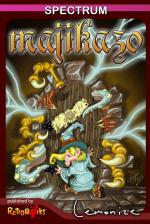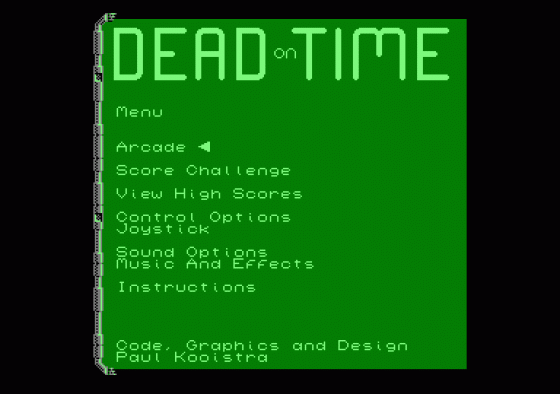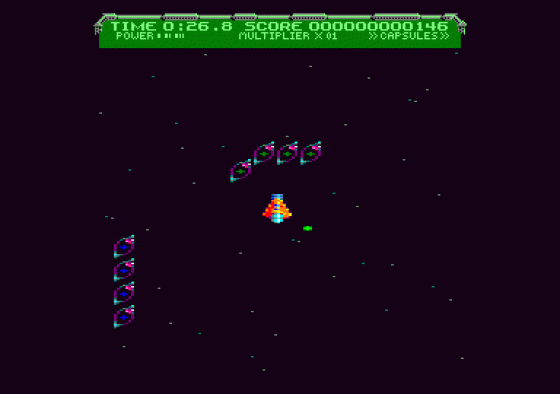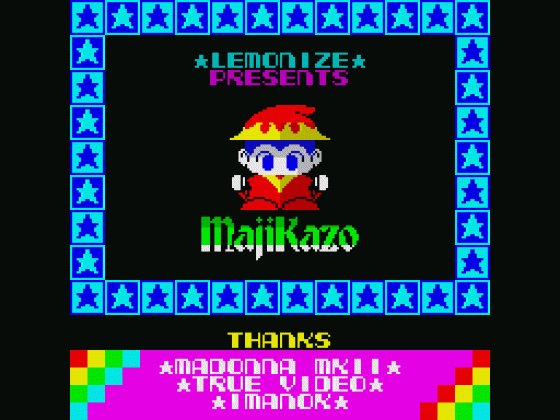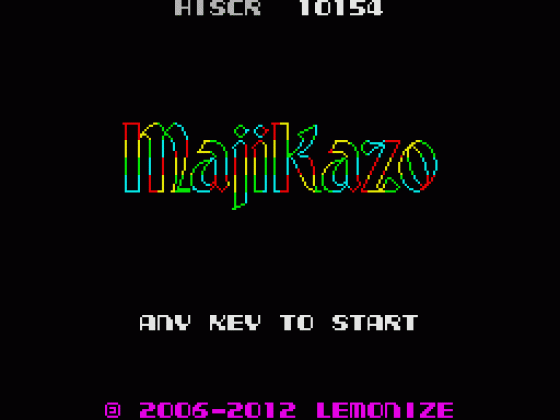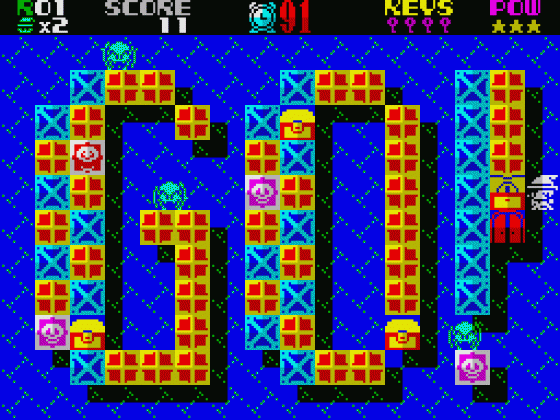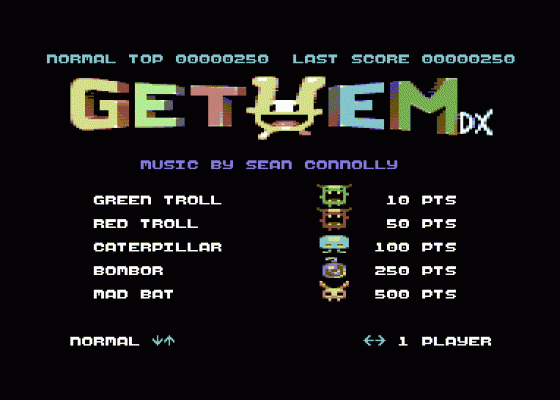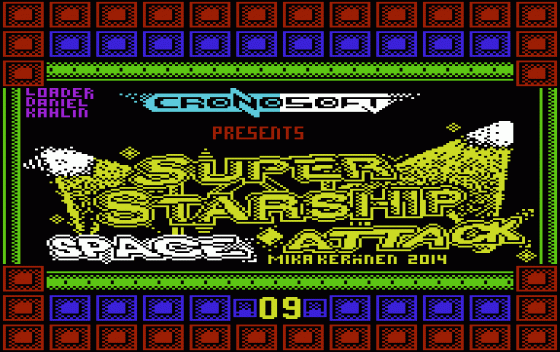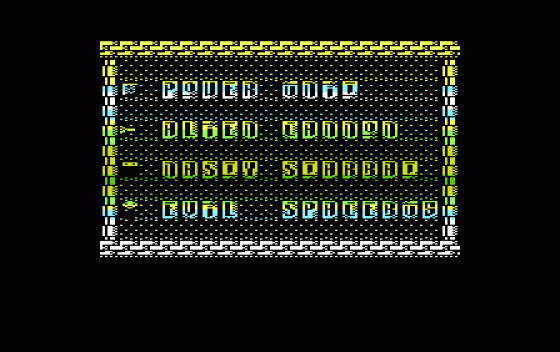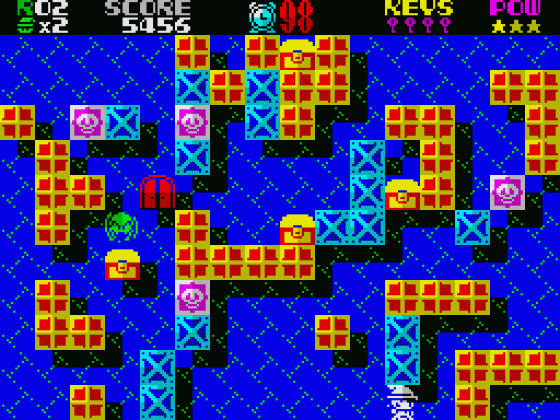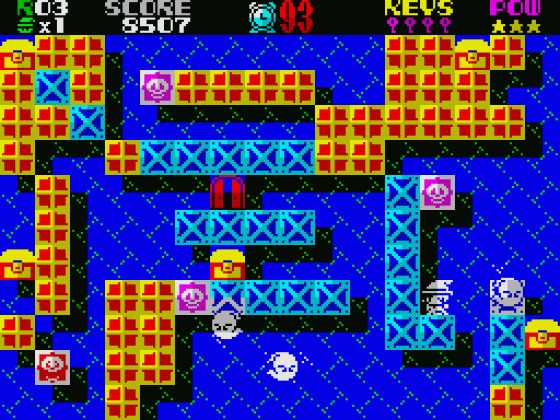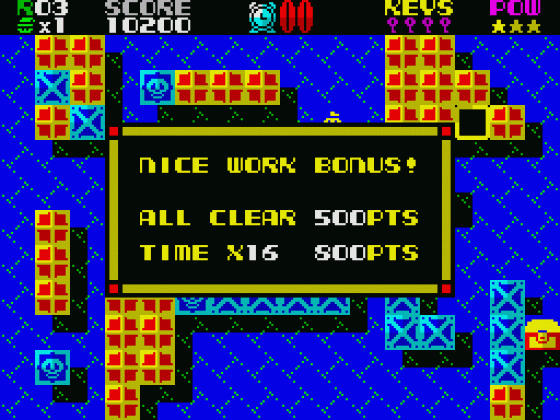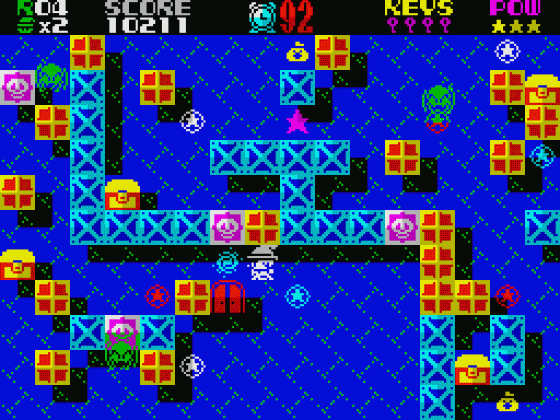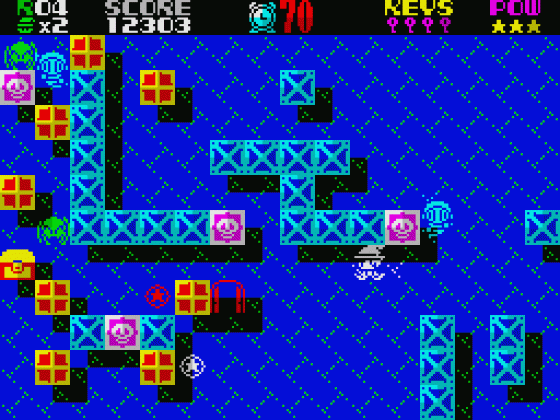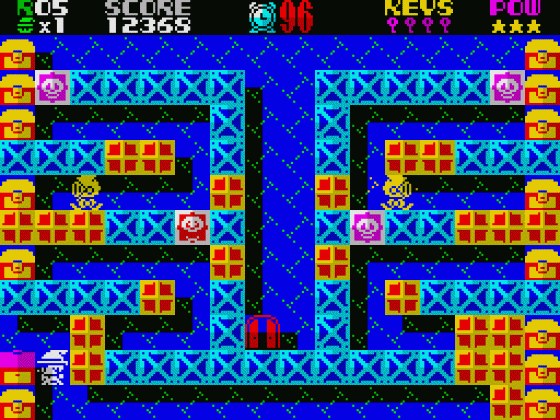
Micro Mart
 28th January 2016
28th January 2016
Categories: Review: Software
Author: Dave E
Publisher: RetroWorks
Machine: Spectrum 48K
Published in Micro Mart #1402: February 2016 Special
Dave Edwards surveys the best of the homebrew scene for the Commodore 64, Amstrad, Spectrum and Vic-20
Introduction
This month, all of the games reviewed in Retro Round-Up require your hard-earned pennies if you wish to play them, with all of them available by mail order only. Yes, you may pay by Paypal, but to add to that true feeling of nostalgia, you'll have to wait for your postman to deliver them to your door, and then load them up an original cassette or disk on your favourite Eighties machine.
Let the reviews begin...
Dead On Time
Something I like (I'm not sure why) is when the title of a game is clever enough in itself to tell you almost everything you need to know. Dead On Time is a great title. Firstly, because the game is played against the clock, and secondly, because you die when the clock hits zero.
The game itself is an overhead shooter but - before you groan and move on - it's quirky enough to be something of a new genre in itself. There's no number of lives, and no energy bar either. Instead, there's simply the timer which relentlessly ticks down to zero.
You are somewhere in deep space where different coloured formations of aliens snake about loosing off bullets towards you. There are two modes of play (which we'll get to in a minute) but in each the aim is to stay alive for as long as possible. The art of staying alive is not to let that timer reach zero. It will get there a whole lot sooner if you collide with the formations or if any of their bullets smash into you - so you first need to master the art of controlling your spaceship.
It moves zippily. In fact, it's a little too fast; find yourself in the line of fire from one alien and taking evasive action can very quickly fling you directly into an alien that's on the other side of the screen. On top of this, aliens come in from the left, right, top and bottom of the playing arena without any warning at all, meaning if you hug the sides of the screen, you'll have no time to get out of their way.
And if that's not tough enough for you, these aliens, once they have entered the playing area, never venture into the outer sections of screen again. So if your playing strategy is to try and pick them off as they glide into your own firing line from the safety of one of the four corners, that won't work.
These factors mean Dead On Time takes a lot of practice; the first few times you play, death is likely to come within seconds rather than minutes. However, once you have developed a strategy, you come to recognise there are usually four aliens in a "chain" and, if you manage to get them all, they leave behind a bonus capsule which, if collected, extends that ever-decreasing timer.
The capsule also has some other qualities - collect three of the same colour and you'll become immune to bullets in that colour for eight seconds. This functionality is incredibly difficult to keep track of. As noted, if you want to stand any chance of staying alive, you need to be inside of the 2" border area of the screen. Trying to remember which capsule colours you've collected whilst dealing with up to 16+ aliens in this small rectangle is really one challenge too far.
Dead On Time has an Arcade and a Score Challenge mode. It also has either joystick or keyboard control. I'm sure the default Arcade mode and joystick option suits some players, although it seemed odd that the menu to deselect these was operated by keyboard only; Score Challenge games last a lot longer than Arcade ones too. So personally I would've thought Score Challenge and keyboard were more sensible defaults. Still, the options are easily altered... once you appreciate how they work.
I've concentrated a lot on playability, and less on sound and graphics, which are, in a word, superb. Suitably up-beat music plays throughout the action and the graphics are multi-coloured and sinister enough for their purpose. One effect I didn't like however was the way the parallax stars altered direction as you manoeuvred your craft. This effect gives the illusion that you can actually fly away into other sections of space. You can't - and this effect is distracting, odd and unnecessary, as are the stars themselves. Sometimes less is more.
In all, it's very tough but also very configurable... and playing against the timer not only works well but is certainly a quirk I've never seen before.
Dead On Time Scores
Graphics 8
Sound 9
Presentation 9
Value For Money 8
Overall 9
Majikazo
Magikazo is a "cleaner wizard" - although a more accurate term would be "ghostbuster" - a man you call when you happen to own a warehouse where things go bump in the night. He turns up and, armed with his magic powers, casts spells which banish the spooks back to wherever they came from.
So says Retroworks' inlay, anyway. I have my doubts as to what's being cast though; these spells behave very much like bullets!
In the game, you take on Magikazo's role, and have to deal with room after room of very colourful, overhead mazes. A nice "rainbow" wipe effect appears as you move between them. How to play is more complicated than you might at first expect but in essence, you have to shoot the walls of the maze to get to the treasure chests. You then shoot the chests themselves to see if they contain one of the four keys that you need to escape from the room.
Out to thwart you are the ghosts, spooks and spiders mentioned earlier. These enter each room through skull-embossed "generator blocks". Each enemy is a different colour. Turning to face an enemy and pressing Space always fires a spell/bullet, but some spells won't defeat some enemies. You start off with the green spell, which defeats the green spider and nothing else. As you shoot the walls of the maze, you'll find spells of other colours (represented as stars) hiding inside. The skill of the game, apart from running and blasting, lies in choosing whether to collect any spell or not. For example, if you're in pursuit of a red monster, and you've got red bullets, don't run across a cyan star en route!
There's an interesting array of meanies - including walking suits of armour and spooks that look like Casper The Friendly Ghost - and there's a great many bonus items that appear in random shot-up areas of maze - including an hourglass that freezes the enemies, winged boots that increase your speed, and candlelight which opens up all the chests immediately. It's also a real boon to see such a game with so much colour running on the Spectrum with no colour clash.
But, for all that, Magikazo really does seem to be missing something. Unforgivably, there's very little sound and a lack of varied level design. Each room looks practically no different to the one before it.
Additionally, the game is somewhat ambivalent about what "completion" of a maze actually entails. You're told to clear each and every room of all enemies because you've been paid to "do your job properly". However, the exit door opens as soon as you have collected the four keys you need.
Thus, those generator blocks can produce a significant amount of additional enemies whilst that exit door remains tantalisingly open. Hanging around to "do your job properly" in the circumstances is hardly an inviting prospect. That's the case even though clearing the room results in a massive bonus which directly influences how many lives you will have to attempt the next one!
Each game starts by announcing "Get Ready For The Show!" I'm still waiting for it...
Magikazo is available as a physical cassette from Retroworks (http://www.retroworks.es) and costs 5 Euro plus postage.
Majikazo
Graphics 7
Sound 5
Presentation 8
Value For Money 5
Overall 7
Get 'Em Dx
Cover art and loading screens can say a lot about a game. Take a look at both for Get 'Em Dx and you'll see they are very cutesy, bringing to mind the glory days of Pokémon and Bubble Bobble. The game casts you in the role of Getty, a big-smiley face dot-muncher in an overhead maze bearing, at least initially, some resemblance to Pac-Man. A second player can also play co-operatively with you as another muncher called Emma (if you can find someone else who loves Commodore 64 games, that is!).
In "the Nyarlu dungeons of Infinity" (Not the most inviting place to find yourself!) are a series of mazes into which Getty (and Emma) will be transported. The mazes are different each time you play, and they may even be randomly generated. Each of them contains crosses or dots and, to complete the maze, all of these must be devoured.
Making life difficult are two things. Firstly, the obvious patrolling Mad Bats and Skellies. These can be dealt with by shooting them. They will explode into bonuses after absorbing a certain number of your shots. Secondly, less obviously the feature of the game that the instructions don't mention but which is a peculiar feature of the game itself and which I call "alignment difficulty".
In most maze games like Get 'Em Dx, the collectables are sprinkled in rows or columns separated by maze walls, and you simply follow these throughout the maze. Indeed, many corridors of the Get 'Em Dx maze follow this practice. However, some areas of it do not - and have collectables grouped together without being separated by maze walls. These areas are significantly more dangerous to patrol, as nasties are no longer forced to advance towards you via a "one-way" passage, and can 'hop' from one "row" or "column" to the next with ease. It's also much harder to take aim at them in these areas too. Obviously, the corollary of this is that it is much easier to die.
"Alignment difficulty" aside, shooting is somewhat hit and miss too. Your bullets travel in the direction in which you're facing, but by holding down fire you "lock" this direction, allowing you to strafe left/right/up/down whilst firing in a "different" direction. This is useful in itself as long as you have a second or two to plan out your attack. The trouble is that it is more usual to find the nasty absorbs one or two bullets then gets out of the way of them and hotly pursues you into a dead end. With no means of shooting backwards at him without - of course! - having to run back into him to make the bullets go in his direction, you can guess the inevitable result.
This brings me to one more point; levels are easier if you play co-operatively rather than alone. If you're being chased down by a meanie, your friend can usually take care of him by shooting him in the back. That's assuming you have a friend interested in helping you out rather than watching you snuff it!
When you manage to blast a nasty, he disintegrates into a number of power-ups. You need to collect nine of the same power-ups to be awarded the power so, if playing co-operatively, you need to share these out between players to maximise fire power, invincibility, etc.
Get 'Em Dx can be played on an Easy, Medium or Hard setting, which varies only how many times the nasties must be shot before disintegrating.
Overall then, the game itself is less cutesy than you might imagine from the cover art. The graphics are fair, everything moves smoothly and the music that accompanies the action is fantastic. Nevertheless, I found survival more a matter of luck than real playing skill. Playing co-operatively with the right friend does help alleviate this, but doesn't banish it completely.
Scores
Graphics 6
Sound 9
Presentation 9
Value For Money 8
Overall 8
Super Starship Space Attack
Cronosoft has been very quiet lately, but has just released this impressive horizontal shooter for the Vic 20. And when I say "impressive", I really mean miraculous. Even when you start strapping memory expansions onto the Vic 20, it still remains limited in what it can do (The Vic pre-dated even the Spectrum by a good few years!).
The scene is deep space and you are in control of a starship inside the belly of a larger spaceship. Scattered around each "level" of the spaceship are three power units, which you fly into to collect. Collect these and make good your escape by flying through the escape area; the door to this will remain stubbornly closed until you do.
The whole game is written in machine code and you quickly learn that your starship magically aligns itself with the tiles over which you are flying over. This is good, because there's less chance of you moving a single pixel too far and smashing into the spaceship's scrolling cavern walls. A tap left or right will always move you the same amount of pixels and no further.
The game is written in a very modern way. The first level is a tutorial - and, following its instructions, you quickly realise that you head up through the spacecraft and then down through it again to reach the escape area. You can travel at a number of different speeds, with a buzz that increases in pitch as you get faster. Guns are mounted on the walls, and every now and then you may also encounter a shooting droid that's also bent on your destruction. Collect a power unit and the screen flashes dramatically. Accidentally shoot it and it's all over for you for that level.
Another thing to watch out for is that, as you move around the spaceship, all the adversaries you've taken care of regenerate as soon as they're scrolled off-screen. This means your return journey will be just as perilous as the journey up to collect the power units in the first place.
Super Starship Space Attack isn't particularly tough - all it takes to complete a level is patience; there's no time limit so you can pick off your adversaries one by one and be assured of success. But, if you take more risks, you can complete levels much more quickly... In reality, that's the battle you're really fighting. That finite control over your starship allows you to pull off dexterous moves and the game is much more impressive played with a "fly fast, die young" mentality than a plodding one.
However you choose to play though, you will be bowled over by it. Despite being monochrome, it's the very definition of slick. The scrolling is super-smooth, featuring parallax scrolls (!), there's an introductory screen that bounces along to a heavy bass track and no less than three modes of play.
It's hard to believe that any game could pack so much into the Vic 20 as this. Bearing in mind the hardware limitations, this may be the best game we're ever going to see for this machine period.
Buy it immediately!
Scores
Graphics 8
Sound 8
Presentation 7
Value For Money 10
Overall 9
That's All Folks!
One thing all four of these games do have in common is the quality of the physical cassette production. Embossed glossy inlays, original artwork and full instructions accompany the game itself and we were, naturally, only joking about "having" to wait for physical delivery in our opening paragraph. Cronosoft, Psytronik and Retro Works will all send you an emulator file by e-mail as well as the physical cassette by post.
Personally, I like to play the emulator files on my PC and store the physical cassettes in an oversized cardboard box. I then constantly trip over it, consider re-selling its contents and then persuade myself that one day the contents of this box of "rare stuff" will be worth a small fortune to someone (other than me).
Until next month, keep playing those retro games...

